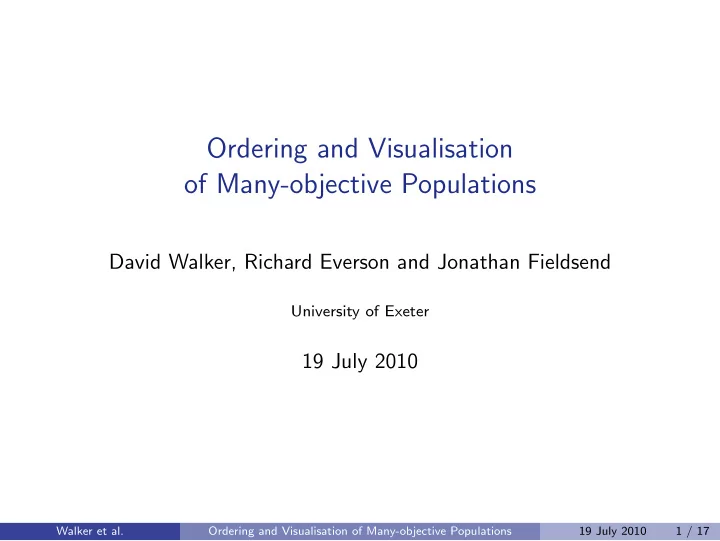

Ordering and Visualisation of Many-objective Populations David Walker, Richard Everson and Jonathan Fieldsend University of Exeter 19 July 2010 Walker et al. Ordering and Visualisation of Many-objective Populations 19 July 2010 1 / 17
Introduction Ordering Many-objective populations League tables are used to rank performance Often multiple key performance indicators measure a single item Information must be drawn from all of these KPIs to come up with a single measure of performance We construct a league table with multiple KPIs applying a single-objective ranking method to a many-objective data set — the Power Index Visualising Many-objective populations Ordering methods can be used to support visualisation We present A new dominance/graph theory-based method A method to improve the comprehension of heatmaps Walker et al. Ordering and Visualisation of Many-objective Populations 19 July 2010 2 / 17
League Table Construction 1 – Oxford An example — university league tables 2 – Cambridge The Times Good University Guide 2009 3 – Imperial 4 – LSE 8 KPIs 5 – St Andrews Weighted sum approach 6 – Warwick 7 – UCL Choosing weights can be difficult 8 – Durham Many-objective Optimisation Concepts 9 – York In MOEAs, dominance approaches replaced 10 – King’s weighted sum methods 11 – Bristol The job of a university is to maximise their 12 – L’borough performance over all KPIs simultaneously 13 – Exeter 14 – Leicester Let y = ( y 1 , . . . , y k ), for k KPIs. 15 – Bath Walker et al. Ordering and Visualisation of Many-objective Populations 19 July 2010 3 / 17
Pareto Sorting Use dominance to locate the Pareto shells Provides a partial ordering Walker et al. Ordering and Visualisation of Many-objective Populations 19 July 2010 4 / 17
A Graphical Visualisation Each university is represented by a node An edge between two universities means that the origin university dominates the destination university Universities are shown in their Pareto shells For clarity, edges between universities are only shown from one shell to the next Walker et al. Ordering and Visualisation of Many-objective Populations 19 July 2010 5 / 17
Shell 5 1�������������� A Graphical Visualisation ��������<�����$'� Shell 4 �������������� Shell 2 �&��/���/����,�� *������+������'� )���������� )�"��6������ �� Shell 1 )���&��"����(� Shell 3 6�������������$,� Shell 6 %������������� 9������������ 6�����,�� Pareto �&��������'�� :�/�������(�� �������������$�� Each university is !�����, � optimal %��"�&����"���'(� -���"���1������� ������������ 4�����"��00� represented by a node ������''� %������������� �����)�"������� � )������"�����0�� ����������������(0� 2�+�������'� �������+������,� 3;��������0� ��������0(� 1��&���"���0� ���������� ���������,,� 1�����&��/�11���,� 1��������'�� ���������� �������������� ���"����(,� �������������0� An edge between two %�5��+�����0�� ����������������'� %��+������� � �������0 � universities means that the 1�5����/����� ��������������� !������,�� %��������� ,� ���"������� � .����������.����$$� ������"�����',� %�5��+����<.��� 0� origin university dominates 4�����+�������� �#������6���������� 7����#�����������'�� 3�1*��� $� !��"#���$� 3�21�1��������$ � ������+����(� the destination university �����������'0� %������0'� ����������0� ����������� ����������������� 9������=����/����0� :������������(� �������������(�� *�����"������'� �&����/���$� -����������� �� *������&������,� -�����"������� Universities are shown in ��������� �����/��0$� ������*����� �� %����������������'� 6���������������$� ���������� � ����������,0� 1�������%��������� their Pareto shells -�����������(�� -���"�����$� 7�����.��/��'$� ���5�����+������ �� ���.������������ 6�����8������,�� 31%��(� ��������/����0,� )������,'� ���������������� � -�����������������,� �#����1��/��($� %�)��,� .�����������' � 4�/���6������/��0�� !��"������� � ��"����4�������� (� For clarity, edges between *����������'�� 3�������('� 1��������$�� �������0� ��������,(� universities are only shown ���&/��$0� ��������0�� �������"��,$� ���������������� '� from one shell to the next *#����9������(�� )����%�������$�� *�+������'� .�����������(� %�����.����$(� 1��/��( � 7.�)���&��"����$� 4�&����-�������((� 1��&�����$�� Walker et al. Ordering and Visualisation of Many-objective Populations 19 July 2010 5 / 17
Constructing the Graph Adjacency matrix W Probability of Dominance W ij = p ( y i ≻ y j ) p ( y i ≻ y j ) = α + β 0 1.0 0.9 α — the fraction of objectives 20 0.8 on which y i is better than y j . 0.7 40 β — half of the fraction of 0.6 0.5 objectives on which y i is 60 0.4 equal to y j . 0.3 80 The probability that y i would 0.2 100 beat y j in a tournament on a 0.1 0.0 single randomly selected 0 20 40 60 80 100 objective Walker et al. Ordering and Visualisation of Many-objective Populations 19 July 2010 6 / 17
Outflow (van den Brink and Gilles, 2009) Consider the population as a graph, and rank the individuals according to the amount of outgoing traffic at each node Outflow σ out i σ out � = W ij i j y i is ranked higher than y j if σ out > σ out y i y j W ij represents a transition from node i to node j . Equivalent to the Average Rank Walker et al. Ordering and Visualisation of Many-objective Populations 19 July 2010 8 / 17
Power Index 1 – Oxford 2 – Imperial 3 – Cambridge Look for the most influential individual 4 – UCL 5 – LSE 6 – Warwick 7 – St Andrews 8 – Durham 9 – King’s 10 – Bristol 11 – York Rank the individuals that dominate the most 12 – N’ham powerful individuals highest 13 – Bath 14 – S’ton 15 – Edinburgh Walker et al. Ordering and Visualisation of Many-objective Populations 19 July 2010 9 / 17
Power Index The power index is the limit of the sequence u t = Wu t − 1 u 0 = 1 u 1 = Wu 0 (equivalent to the average rank and outflow, u 1 = σ out ) i u 2 = Wu 1 (the average rank, with some proportion of the average rank of dominated universities) . . . u t u = lim t →∞ i u t � i Walker et al. Ordering and Visualisation of Many-objective Populations 19 July 2010 10 / 17
Recommend
More recommend